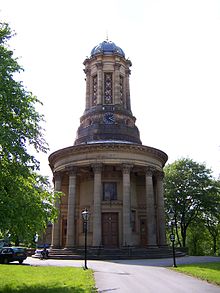Saltaire
![]()
This article is about the place in Great Britain. For the place in the USA, see Saltaire (New York).
Saltaire is a Victorian model settlement founded in 1851 near Bradford in the Metropolitan Borough of City of Bradford in the county of West Yorkshire. The settlement was named after its founder, Sir Titus Salt, and the River Aire in whose valley it lies.
From 1851 the cloth manufacturer Titus Salt moved his business from Bradford to what is now Saltaire, where he had a workers' settlement built around the newly built Salts Mill factory for the 3,000 or so workers and their dependants in accordance with the most modern social and sanitary principles of the time. In addition to the workers' dwellings, numerous communal facilities were built, including a church, a school, a park, a hospital, wash and bath houses, a poorhouse, allotments and an educational institute with a library, reading room, concert hall and gymnasium. A boathouse for the inhabitants and a harbour for the factory were built on the Leeds and Liverpool Canal. The pub, common in English towns, was dispensed with on the instructions of Titus Salt; it is unclear whether this was due to health considerations or to prevent the possible formation of a trade union in a space which Salt found difficult to control.
The buildings of yellow natural stone are in the style of the Italian Renaissance. Titus Salt commissioned the most famous architects of the time with the planning and execution, for the overall planning and the residential buildings the office of Lockwood and Mawson drew the plans.
The former factory buildings now house a variety of uses, in addition to an exhibition of David Hockney's work and the Victorian Reed Organ Museum harmonium, they also house a shopping centre, apartments and a manufacturer of consumer electronics equipment.
Saltaire is now considered one of the world's most important model settlements of the 19th century. The settlement was inscribed on the UNESCO World Heritage List in 2001, along with the Derwent Valley and New Lanark industrial landscapes, and is a so-called anchor point of the European Route of Industrial Heritage. The United Reformed Church of 1859 is considered one of the most important Victorian church buildings in Britain.

United Reformed Church of the East

Salts Mill in Saltaire (south facade)
Questions and Answers
Q: What is Saltaire?
A: Saltaire is a UNESCO World Heritage Site located in the City of Bradford, West Yorkshire, England.
Q: What is unique about Saltaire?
A: Saltaire is a complete and well-preserved industrial village of the second half of the 19th century that has textile mills, public buildings, and workers' housing.
Q: Where is Saltaire located?
A: Saltaire is located in the City of Bradford, West Yorkshire, England.
Q: Why was Saltaire designated as a UNESCO World Heritage Site?
A: Saltaire was designated as a UNESCO World Heritage Site due to its exceptional value as a complete and well-preserved industrial village from the second half of the 19th century.
Q: What kind of buildings can be found at Saltaire?
A: At Saltaire, there are textile mills, public buildings, and workers' housing.
Q: When was Saltaire built?
A: Saltaire was built during the second half of the 19th century.
Q: Is Saltaire an important historical site?
A: Yes, Saltaire is an important historical site and has been designated as a UNESCO World Heritage Site due to its exceptional value.
Search within the encyclopedia